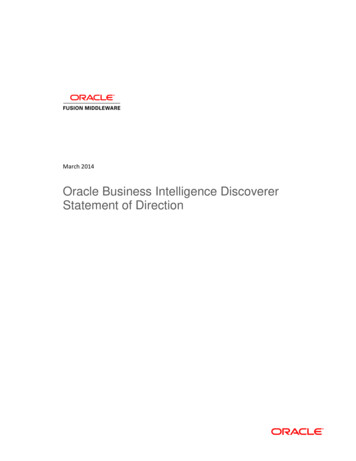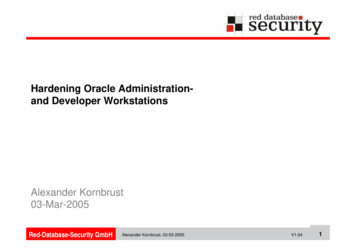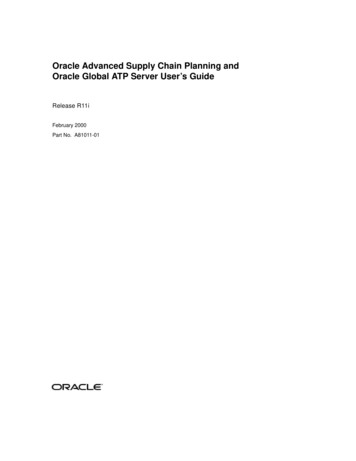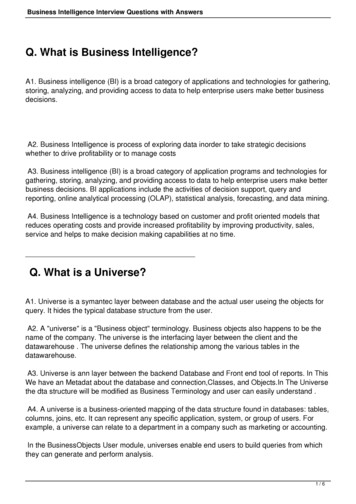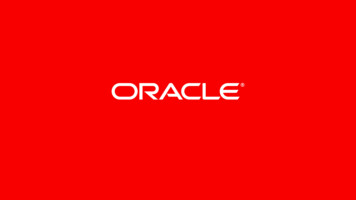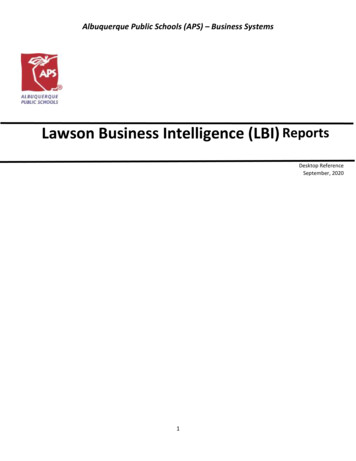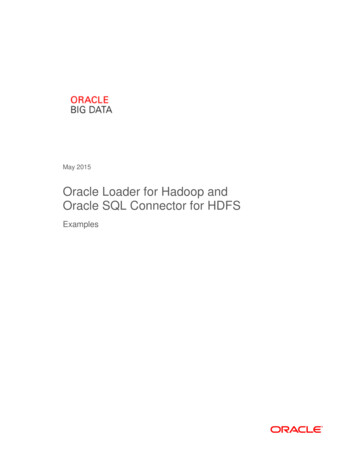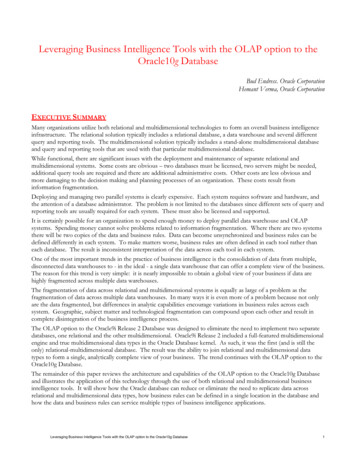
Transcription
Leveraging Business Intelligence Tools with the OLAP option to theOracle10g DatabaseBud Endress. Oracle CorporationHemant Verma, Oracle CorporationEXECUTIVE SUMMARYMany organizations utilize both relational and multidimensional technologies to form an overall business intelligenceinfrastructure. The relational solution typically includes a relational database, a data warehouse and several differentquery and reporting tools. The multidimensional solution typically includes a stand-alone multidimensional databaseand query and reporting tools that are used with that particular multidimensional database.While functional, there are significant issues with the deployment and maintenance of separate relational andmultidimensional systems. Some costs are obvious – two databases must be licensed, two servers might be needed,additional query tools are required and there are additional administrative costs. Other costs are less obvious andmore damaging to the decision making and planning processes of an organization. These costs result frominformation fragmentation.Deploying and managing two parallel systems is clearly expensive. Each system requires software and hardware, andthe attention of a database administrator. The problem is not limited to the databases since different sets of query andreporting tools are usually required for each system. These must also be licensed and supported.It is certainly possible for an organization to spend enough money to deploy parallel data warehouse and OLAPsystems. Spending money cannot solve problems related to information fragmentation. Where there are two systemsthere will be two copies of the data and business rules. Data can become unsynchronized and business rules can bedefined differently in each system. To make matters worse, business rules are often defined in each tool rather thaneach database. The result is inconsistent interpretation of the data across each tool in each system.One of the most important trends in the practice of business intelligence is the consolidation of data from multiple,disconnected data warehouses to - in the ideal - a single data warehouse that can offer a complete view of the business.The reason for this trend is very simple: it is nearly impossible to obtain a global view of your business if data arehighly fragmented across multiple data warehouses.The fragmentation of data across relational and multidimensional systems is equally as large of a problem as thefragmentation of data across multiple data warehouses. In many ways it is even more of a problem because not onlyare the data fragmented, but differences in analytic capabilities encourage variations in business rules across eachsystem. Geographic, subject matter and technological fragmentation can compound upon each other and result incomplete disintegration of the business intelligence process.The OLAP option to the Oracle9i Release 2 Database was designed to eliminate the need to implement two separatedatabases, one relational and the other multidimensional. Oracle9i Release 2 included a full-featured multidimensionalengine and true multidimensional data types in the Oracle Database kernel. As such, it was the first (and is still theonly) relational-multidimensional database. The result was the ability to join relational and multidimensional datatypes to form a single, analytically complete view of your business. The trend continues with the OLAP option to theOracle10g Database.The remainder of this paper reviews the architecture and capabilities of the OLAP option to the Oracle10g Databaseand illustrates the application of this technology through the use of both relational and multidimensional businessintelligence tools. It will show how the Oracle database can reduce or eliminate the need to replicate data acrossrelational and multidimensional data types, how business rules can be defined in a single location in the database andhow the data and business rules can service multiple types of business intelligence applications.Leveraging Business Intelligence Tools with the OLAP option to the Oracle10g Database1
INTRODUCTIONThere are two sections to this paper. This first reviews the architecture and capabilities of the OLAP option to theOracle10g Database. It will focus on the multidimensional engine and data types, and how applications can withthem. The first section will also discuss the problem information fragmentation in more detail.The second part of the paper demonstrates how several different types of tools commonly used in a businessintelligence system can use a single database instance containing a single copy of the data and the business rules.REVIEW OF THE OLAP OPTION TO THE ORACLE 10G DATABASEIn the context of this discussion, the best way to describe the Oracle 10g Database is as a relational-multidimensionaldatabase. The Oracle 10g Database includes both relational and multidimensional (OLAP) capabilities in a singledatabase instance. Oracle 10g is not a compromise between the two technologies - it is both a full featured relationaldatabase and a full featured multidimensional database. Perhaps most importantly, the Oracle 10g Database allowsboth relational and multidimensional data types work together. For example, they can to be joined in a single queryusing either an OLAP API or SQL.CAPABILITIES OF THE OLAP OPTIONThe OLAP option to the Oracle 10g database is a full-featured multidimensional engine within the context of theOracle Database. It features: An industrial strength multidimensional calculation engine. Multidimensional data types. An OLAP API. A SQL interface. The OLAP catalog.The multidimensional calculation engine provides support for a wide variety of multidimensional calculations andplanning functions. Multidimensional queries are characterized as being calculations that cross multiple dimensionswithin a single query. For example, a query such as "what is the change in net profit resulting from the top 20% ofcustomers for year to date this year as compared with a similar period last year for a grouping of my top 10 brands”crosses three dimensions (product, customer and time). While this might be very difficult to express in SQL, it wouldbe simple using the OLAP options OLAP DML (a dimensionally aware data manipulation language).Planning functions include statistical forecasts, models, allocations and projections or 'what-if' scenarios. The OLAPoption includes an impressive library of planning functions and supports what-if scenarios through a read-repeatable,session isolated transaction model.The OLAP option provides true array-based multidimensional data types within the Oracle database. Some data typesare used for data storage – for example, dimension lists, relations and variables. Others, such as models, formulas andaggregation maps are used for persisting calculations and business rules. Calculations are defined using the OLAPDML, a dimensionally aware data manipulation language supported by the multidimensional engine. The OLAPDML is a high level procedural language that is accessible to DBAs and developers alike.It is important to note that these multidimensional data types are stored in Oracle data files (in contrast to stand alonemultidimensional databases that store multidimensional data in separate data files). Because multidimensional datatypes are stored in Oracle data files, they are administered along with all other Oracle data (for example, backup andrestore).The OLAP API is a Java, object oriented API that provides a multidimensional object model, metadata discovery andsupport for multidimensional data selection, navigation and calculations. The OLAP option supports both relationaland multidimensional data types as data sources. As such, it supports both relational OLAP (ROLAP) andmultidimensional OLAP (MOLAP).The OLAP option's SQL interface provides SQL access to multidimensional data types. This is allows SQL basedapplications such as report generators and ad-hoc query tools to access data and calculations managed by OLAPLeveraging Business Intelligence Tools with the OLAP option to the Oracle10g Database2
option.Finally, the OLAP catalog is the companion to the Oracle data dictionary. It includes a repository and API thatsupports the definition and discovery of logical multidimensional models and mappings to physical data sources.OLAP AS PART OF THE DATA WAREHOUSEMultidimensional databases have almost always been views as being external to the data warehouse. In his widely read1996 book The Data Warehousing Toolkit1, Ralph Kimball, an early data warehousing expert, described OLAPvendors as selling "proprietary, nonrelational decision support products that compete as replacements for relationaldatabases and SQL-based front end tools”. Mr. Kimball's basis for this opinion was quite reasonable. "At the time ofthis writing, these are the most serious issues for an IS department relative to OLAP products The OLAP products are not open. That is, they do not process standard SQL. The OLAP products do not scale to enterprise-sized data warehouses. These products cannot store and query theequivalent of a billion-row fact table”Largely because of these problems, but also because multidimensional databases were less mature in terms of highavailability, security and other important areas of functionality, multidimensional databases have never really beaccepted as part of the core data warehouse. After all, if they didn't scale to warehouse sized data sets and they couldnot support the business intelligence tools typically used to access the warehouse, it is difficult to consider them partof the data warehouse.SQLRelational ToolsDataReplicationProcessData WarehouseOLAP ToolsTypical Environment With Both Data Warehouse and Stand Alone OLAPTo various degrees, vendors have solved scalability problems with multidimensional databases and it is notuncommon to see vary large multidimensional data sets. Until Oracle9i Release 2, when the OLAP option'smultidimensional engine and data types were introduced to the Oracle Database, no vendor had solved the problemsrelated to high-availability, security and openness to SQL based applications.With the OLAP option to the Oracle Database, it is now possible to consider multidimensional OLAP data as beingpart of the data warehouse. The following points support this proposition: The OLAP option supports SQL access to multidimensional data and calculations. The OLAP option supports very large multidimensional data sets. Data sets in excess of a billion rows are nowcommon. Multidimensional data sets stored in the Oracle Database enjoy the same high availability and security features asall other data in the Database. It is now possible to trust the enterprise's mission critical data to multidimensionaldata sets.With the Oracle Database, you can now consider a data warehouse environment that includes both relational andmultidimensional data types. Rather than building a relational data warehouse and a separate multidimensional1The Data Warehouse Toolkit, Ralph Kimball, 1996, John Wiley & Sons, Inc., New YorkLeveraging Business Intelligence Tools with the OLAP option to the Oracle10g Database3
database for OLAP, you can simply choose between relational and multidimensional data types within the OracleDatabase.With the Oracle Database, the choice of data types is simply based on the characteristics of the data and calculationsrequirements. Two systems can be combined as one with the resulting improvements to the end user experience, theelimination of data and analytic fragmentation and lower costs.RelationalData TypesSQLOLAP APIClientsMultidimensionalData TypesData WarehouseData warehouse with both relational and multidimensional data typesHOW APPLICATIONS QUERY OLAP DATAUnderstanding the interfaces provided by the OLAP option – SQL and the OLAP API – is key to understanding howa wide variety of business intelligence tools and applications can be used with the OLAP option.SQL INTERFACE TO MULTIDIMENSIONAL DATA TYPESThe SQL interface to multidimensional data types uses the Oracle Database's object technology to representmultidimensional data types to the Database's relational engine. The OLAP TABLE table function, animplementation of the Database's object technology, is used to (a) transform SELECT statements from SQL to theOLAP option's OLAP DML and (b) transform multidimensional data sets being returned by the multidimensionalengine to the format of a relational row set.The process of querying multidimensional data sets using the OLAP TABLE table function can be made completelytransparent to the client application. Or, the application can be aware that the source of the data is multidimensionaland leverage this knowledge by interacting with the multidimensional engine from within a SELECT statement orthrough PL/SQL.The process of enabling SQL access to multidimensional data types is relatively simple – it is only necessary to definetwo abstract data types. A one abstract data type identifies the structure of the row set; the other indicates that thedata source can be queried is if it is a table. Optionally, a relational view can be defined over the multidimensionaldata set to make the multidimensional source of the data completely transparent to a SQL application.In order to understand the SQL interface, it is useful to view a simple implementation. The following illustrates acommon implementation where a multidimensional data set is revealed to an application as a star schema. Two views,one for a dimension view and other for a fact view, are shown.DEFINING ACCESS TO A TIME DIMENSIONAnytime SQL will be used to access multidimensional data types two abstract data types – one as an OBJECT and theother as a TABLE – must be created. The OBJECT abstract data types defines the columns and data types. Forexample:CREATE TYPE time type row AS object ;The corresponding TABLE abstract data type follows:Leveraging Business Intelligence Tools with the OLAP option to the Oracle10g Database4
create type time type table as table of time type row;While the creation of these two abstract data types are the only requirements for setting up access, it is common tocreate views to make the multidimensional data types transparent to the application. The following example creates aview for a time dimension lookup table.CREATE OR REPLACE VIEW time view ASSELECT *FROM TABLE(OLAP TABLE('global DURATION SESSION','time type table','limit time KEEP time levelrel ''MONTH''','DIMENSION time WITHHIERARCHY time parentrelLEVELREL year, quarter, monthFROM time familyrel USING time levellist'));Note that the FROM clause selects from the OLAP TABLE table function rather than a table or view. TheOLAP TABLE table function accepts a number of arguments that map it to the analytic workspace and objectswithin it. These arguments are briefly described below: GLOBAL is the user-defined name of the analytic workspace. DURATION describes the transaction model (either read repeatable view of the analytic workspace during thesession, or a view that immediately recognizes any changes to the data in the analytic workspace). TIME TYPE TABLE binds the view to the abstract data type that was created above. 'limit time KEEP time levelrel ''MONTH''' is an OLAP DML command that is executed as part of the SELECTstatement. (This command constrains time dimension in the analytic workspace to members at the month level.This is done so that only months are returned at rows. Higher-level members – quarters and years – are returnedas columns.) The DIMENSION clause maps relational columns (described in the abstract data type) to multidimensional datatypes in the analytic workspace. The example shown illustrates some hierarchical structures(TIME FAMILYREL and TIME LEVELLIST) in the analytic workspace being used to select quarter and yearmembers as columns in the view).DEFINING A ACCESS TO FACTSThe process of defining access to fact data is very similar to that for the time dimension data. Again, two abstract datatypes are required:create type sales type row as object (time idvarchar2(5),channel idvarchar2(5),product idvarchar2(5),customer idvarchar2(5),salesnumber,unitsnumber,extended costnumber,forecast salesnumber,olap calcraw(32));create type sales type table as table of sales type row;In this example, the ' id' columns will represent the keys. The columns SALES, UNITS, EXTENDED COST andFORECAST SALES are the facts or measures. The OLAP CALC column is very special – it is used to includeLeveraging Business Intelligence Tools with the OLAP option to the Oracle10g Database5
OLAP DML expressions in the select list (example to follow).The fact view can be created as follows:create or replace view sales view asselect *from table(OLAP TABLE('global DURATION session','sales type table','','DIMENSION time id FROM timeDIMENSION channel id FROM channelDIMENSION product id FROM productDIMENSION customer id FROM customerMEASURE sales FROM salesMEASURE units FROM unitsMEASURE extended cost FROM extended costMEASURE forecast sales FROM fcast salesROW2CELL olap calc'));The DIMENSION keyword maps dimensions in the analytic workspace to columns that act as keys in the fact view.Measures, which can be any data in the analytic workspace that is dimensioned by at least one of the dimensions in theview, are mapped using the MEASURE keywords. ROW2CELL indicates that an OLAP DML expression can beused in the select list when selecting from this view.SELECTING DIRECTLY FROM OLAP TABLEIt is not necessary to create a view in order to select from an analytic workspace – applications can select directly fromOLAP TABLE (it is necessary to create the abstract data types before selecting from OLAP TABLE). The followingexample illustrates a select statement that selects directly from OLAP TABLE:selecttime id,channel id,product id,customer id,salesfrom table(OLAP TABLE('global DURATION session','sales type table','','DIMENSION time id FROM timeDIMENSION channel id FROM channelDIMENSION product id FROM productDIMENSION customer id FROM customerMEASURE sales FROM sales'))where time id '2003'and channel id 'CATALOG'and product id in ('GUNS','LIPSTICK')and customer id 'TEXAS';USING OLAP DML EXPRESSIONS IN SQL BASED APPLICATIONSThe OLAP DML is used to define calculations in the analytic workspace. OLAP DML is a procedural language thatcan be used to: Define new objects in the analytic workspace and assign data to them. Define and execute ETL processes in the analytic workspaces (e.g., define data loading operations, aggregations,forecasts, allocations and other calculations). Define runtime calculations.There are three ways in which OLAP DML can be used in a SQL application:Leveraging Business Intelligence Tools with the OLAP option to the Oracle10g Database6
1. As an OLAP DML command argument to OLAP TABLE. OLAP DML command arguments are often used toapply additional predicates or to perform some sort of calculations as part of the select statement, for examplerunning a forecast.2. As an OLAP expression included in the select list using the OLAP EXPRESSION function. This can be toeither select from an object (for example, a formula or variable) that is not listed in the OBJECT abstract datetype or to define a new calculation that persists only for the duration of the query. Common examples wouldinclude functions for time series such as leads and lags, comparisons with prior periods and market shares.3. As an OLAP DML command issued through PL/SQL. This allows the application to interact directly with themultidimensional engine outside the context of a select statement. There are many uses for this method includingdata loading, defining calculations that are persisted in the analytic workspace, updating and for applyingpredicates using the OLAP DML prior to selecting data with SQL.USING AN OLAP DML COMMAND IN OLAP TABLEThe example below illustrates the use of an OLAP DML command as an argument to OLAP TABLE. This examplecalls a stored procedure that executes a statistical forecast. Because the OLAP DML is command is executed after theapplication of the where clause, the forecast is run only for those products, customers and channels in the whereclause.selecttime id,channel id,product id,customer id,salesfrom table(OLAP TABLE('global DURATION session','sales type table','forecast sales','DIMENSION time id FROM timeDIMENSION channel id FROM channelDIMENSION product id FROM productDIMENSION customer id FROM customerMEASURE sales FROM sales'))where time id '2003'and channel id 'CATALOG'and product id in ('GUNS','LIPSTICK')and customer id 'TEXAS';Alternatively, a view could be created that includes the OLAP DML command. The following view and selectstatement would yield the same results as the preceding example.create or replace view sales view asselect *from table(OLAP TABLE('global DURATION session','sales type table','forecast sales','DIMENSION time id FROM timeDIMENSION channel id FROM channelDIMENSION product id FROM productDIMENSION customer id FROM customerMEASURE sales FROM salesMEASURE units FROM unitsMEASURE extended cost FROM extended costMEASURE forecast sales FROM fcast salesROW2CELL olap calc'));selecttime id,channel id,product id,Leveraging Business Intelligence Tools with the OLAP option to the Oracle10g Database7
customer id,salesfrom sales viewwhere time id '2003'and channel id 'CATALOG'and product id in ('GUNS','LIPSTICK')and customer id 'TEXAS';Using the OLAP EXPRESSION FunctionWhen used in the select list, OLAP DML can be used as an expression that returns data for a cell (or row, as it is seenwhen returned through SQL) as shown in the following example:select product id,time id,sales,olap expression(olap calc,'lagdif(sales,1,time,status)')as SALES CHG PRIOR PRIOD,olap expression(olap calc,'sales/sales(product ''1'') * 100')as PRODUCT SHAREfrom sales olap viewwhere time id '2003'and channel id 'CATALOG'and product id in ('GUNS','LIPSTICK')and customer id 'TEXAS';In this example the OLAP expression is passed to the multidimensional engine, evaluated and returned as a column.USING OLAP DML COMMANDS IN PL/SQLSometimes is it is useful to be able to issue OLAP DML commands directly to the multidimensional engine prior tothe execution of a SELECT statement. Common examples are the application of predicates to constrain the cube andcommands that change data (that is, commands that update cells in a variable). The following example does both aspart of an application that allows a user to specify assumptions for the effectiveness of a promotional campaign andproject the resulting sales.The example makes the assumption promotional sales will be 115% of the baseline sales projection for the selectedperiods. First, the cube is constrained to certain time periods, items that are children of the family 'LAPTOP', andcertain members of the channel and customer dimensions. Next, the data for PROMOTIONAL SALES arecalculated.execute dbms aw.execute('limit TIME to ''SEP03'' ''OCT03'' ''NOV03''')execute dbms aw.execute('limit PRODUCT to descendants using PRODUCT PARENT'LAPTOP'')execute dbms aw.execute('limit PRODUCT to PRODUCT LEVEL ''ITEM''')execute dbms aw.execute('limit CHANNEL to ''INTERNET''')execute dbms aw.execute('limit CUSTOMER to ''AMERICAS'')execute dbms aw.execute('PROMOTIONAL SALES SALES * 1.15')The next part of the example constrains the cube to the top 20% of customers at the account level based on theprojected values of PROMOTIONAL SALES.limit CUSTOMER to descendants using CUSTOMER PARENT'AMERICAS'limit CUSTOMER keep CUSTOMER LEVEL 'ACCOUNT'limit CUSTOMER keep top 20 percent based onPROMOTIONAL SALESLeveraging Business Intelligence Tools with the OLAP option to the Oracle10g Database8
And then the data can be fetched using a SELECT statement.select time id,product id,channel id,customer idPROMOTIONAL SALESFrom OLAP SALES VIEW;Note that a WHERE clause was not required because the predicates where already applied using OLAP DML LIMITcommands.DENORMALLIZED FACT VIEWSIf disk storage and processing power where both infinite, people might design warehouse schema based on ease ofquery rather than on storage and processing efficiency. The easiest warehouse schema to query might be one thatincluded all data – both dimension members and facts – in a single table. With such a design, hierarchical data such aschild-parent-ancestor data, non-hierarchical attributes and text descriptors could be embedded within the fact view.Joins would be rarely needed. Hierarchical selections would be relatively simple.In a relational data warehouse, such a design would be prohibitively expensive in terms of storage and processing.Although the physical model of the analytic workspace is fully normalized and thus a very efficient means of storingdimensional data, the OLAP option can very efficiently present the data in a normalized fact view. (Themultidimensional engine features automatic referential integrity and transparent joints – including outer joins – thatfacilitate both efficient storage and denormalized views of the data).An example of a normalized fact view follows. Note that the view contains dimension members (at all levels ofsummarization), attributes such as text labels, full hierarchical lineage (child-parent-ancestor relationship) and levelattributes.CREATE TYPE dnorm fact type row AS object (time idvarchar(5),/*time levelvarchar(30), /*time descvarchar(30), /*time /*yearvarchar(5),/*customer idvarchar(5),customer levelvarchar(30),customer descvarchar(30),ship tovarchar(5),accountvarchar(5),market segmentvarchar(5),total (5),all customersvarchar(5),product levelvarchar(30),product descvarchar(30),product varchar(5),total productvarchar(5),channel idvarchar(5),channel levelvarchar(30),channel descvarchar(30),channelvarchar(5),all channelsvarchar(5),Leveraging Business Intelligence Tools with the OLAP option to the Oracle10g Databasetime membertime member's leveltime text labelattribute of time membermonth of the time memberquarter of the time memberyear of the time member*/*/*/*/*/*/*/9
salesunitsextended costforecast salesolap calcnumber,number,number,number,raw(32));/* sales fact*/create type dnorm fact type table as table of dnorm fact type row;create or replace view dnorm fact view asselect *from table(OLAP TABLE('global DURATION session','dnorm fact type table','','DIMENSION time id FROM time WITHHIERARCHY time parentrelLEVELREL year, quarter, monthFROM time familyrel USING time levellistATTRIBUTE time level FROM time levelrelDIMENSION customer id from customer WITHHIERARCHY customer parentrel(customer hierlist ''MARKET ROLLUP'')LEVELREL null,null,null,total market,market segment,account,nullFROM customer familyrel USING customer levellistHIERARCHY customer parentrel(customer hierlist ''SHIPMENTS ROLLUP'')LEVELREL all customers,region,warehouse,null,null,null,ship toFROM customer familyrel USING customer levellistATTRIBUTE customer level FROM customer levelrelDIMENSION product id FROM product WITHHIERARCHY product parentrelLEVELREL total product, class, family, itemFROM product familyrel USING product levellistATTRIBUTE product level FROM product levelrelDIMENSION channel id FROM channel WITHHIERARCHY channel parentrelLEVELREL all channels, channelFROM channel familyrel USING channel levellistATTRIBUTE channel level FROM channel levelrelMEASURE time desc FROM time long descriptionMEASURE time order FROM time orderMEASURE channel desc FROM channel long descriptionMEASURE customer desc FROM customer long descriptionMEASURE product desc FROM product long descriptionMEASURE sales FROM salesMEASURE units FROM unitsMEASURE extended cost FROM extended costMEASURE forecast sales FROM FCAST SALESROW2CELL olap calc'));While this view might look complex, it's really not. Note that there are only three basic parts to the view: (1) thebinding to the analytic workspace and abstract data type, (2) the dimension clauses, and (3) the measure clauses. Eachpart follows the same repeating pattern in each view. Once the basic contruction is understood, creating them isrelatively easy.Querying such a view is very simple because joins are not needed and hierarchical attributes are provided. In thefollowing example, applying predicates to level attribute columns specifies level selections.select time desc,Leveraging Business Intelligence Tools with the OLAP option to the Oracle10g Database10
fromwhereandandandorderproduct desc,customer desc,channel desc,sales,forecast salesdnorm fact viewtime level 'YEAR'product level 'TOTAL PRODUCT'channel level 'ALL CHANNELS'customer level 'ALL CUSTOMERS'by time order;In the next example, we see a select statement that selects the children of your '2003':select time desc,customer desc,sales,forecast salesfrom dnorm fact viewwhere year '2003'and time level 'QUARTER'and product level 'TOTAL PRODUCT'and channel level 'ALL CHANNELS'and customer level 'TOTAL MARKET'order by time order;'SOLVED CUBES'Many of the preceding examples have shown how you can access the multidimensional engine to define calculations atruntime through SELECT statements. In most cases, however, many or most of the calculation rules are predefinedand persisted in the analytic workspace. Examples include aggregations and allocations, models, forecasts andformulas.To the application, the cube appears to be fully solved (materialized) regardless of whether data is calculated andstored or if it is calculated dynamically at runtime. This is because the multidimensional engine automaticallycalculates data points in the analytic workspace based on the predefined calculation rules. For example, all summarydata are automati
With the Oracle Database, you can now consider a data warehouse environment that includes both relational and multidimensional data types. Rather than building a relational data warehouse and a separate multidimensional 1 The Data Warehouse Toolkit, R





